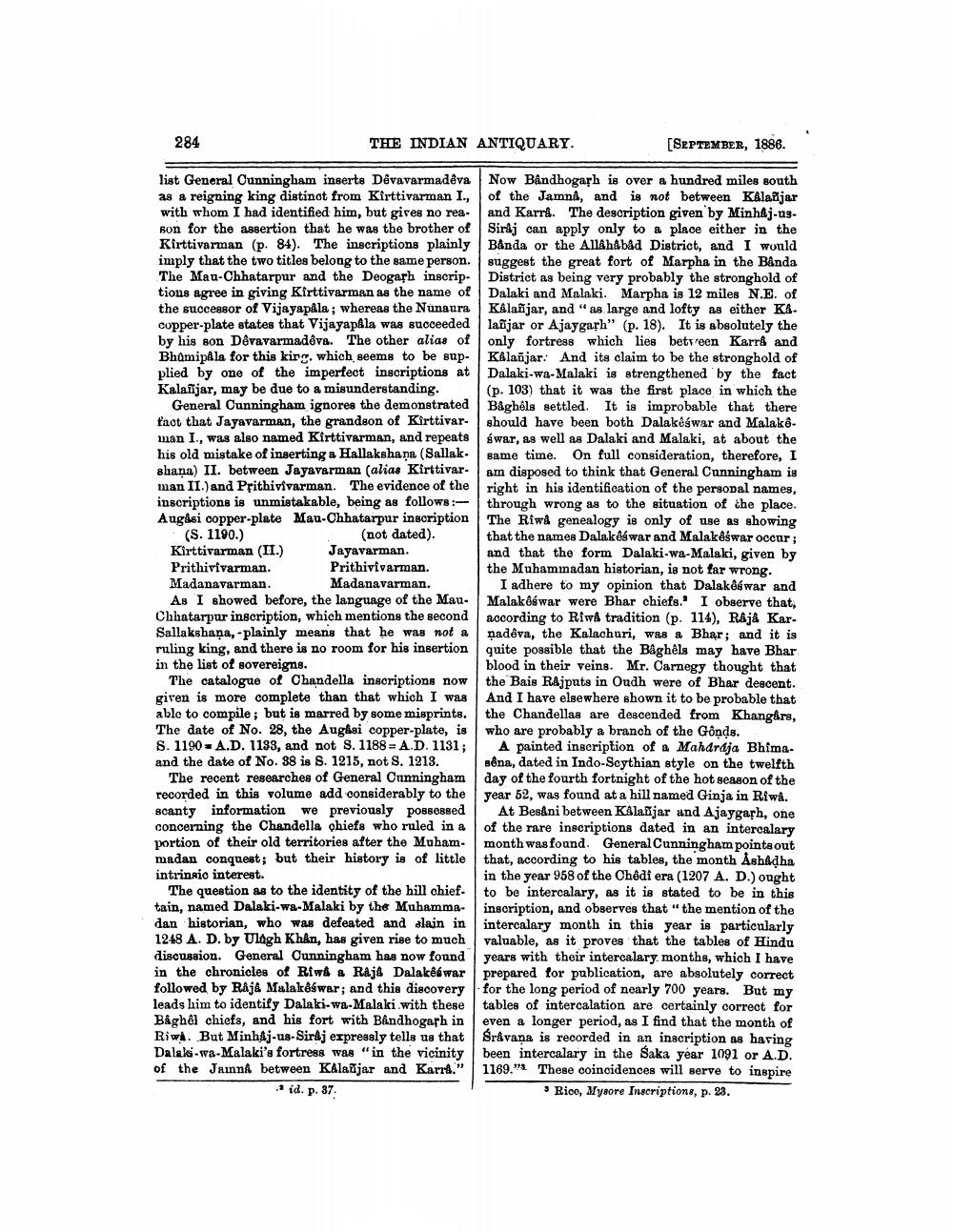________________
284
THE INDIAN ANTIQUARY.
[SEPTEMBER, 1886.
list General Cunningham inserts Dévavarmadêva Now Båndhogaph is over a hundred miles south as a reigning king distinct from Kirttivarman I., I of the Jamna, and is not between Kalasijar with whom I had identified him, but gives no rea and Karra. The description given by Minhaj-ugBon for the assertion that he was the brother of Siraj can apply only to a place either in the Kirttivarman (p. 84). The inscriptions plainly Bånda or the Allâhâbâd District, and I would imply that the two titles belong to the same person. suggest the great fort of Marpha in the Banda The Mau-Chhatarpur and the Deogash inscrip- District as being very probably the stronghold of tions agree in giving Kirttivarman as the name of Dalaki and Malaki. Marpha is 12 miles N.E. of the successor of Vijayapåla ; whereas the Nunaura Kalañjar, and "as large and lofty as either Ki. copper-plate states that Vijayapala was succeeded laõjar or Ajaygarh" (p. 18). It is absolutely the by his son Dêvavarmadêva. The other alias of only fortress which lies betvreen Karra and Bhamipala for this king, which seems to be sup- KAlañjar. And its claim to be the stronghold of plied by one of the imperfect inscriptions at Dalaki-wa-Malaki is strengthened by the fact Kalasijar, may be due to a misunderstanding. (p. 103) that it was the first place in which the
General Cunningham ignores the demonstrated Båghệls settled. It is improbable that there taot that Jayavarman, the grandson of Kirttivar- should have been both Dalakeswar and Malakê. man I., was also named Kirttivarman, and repeats Śwar, as well as Dalaki and Malaki, at about the his old mistake of inserting a Hallakshana (Sallak. same time. On full consideration, therefore, I shana) II. between Jayavarman (alias Kirttivar. am disposed to think that General Cunningham is man II.) and Prithivivarman. The evidence of the right in his identification of the personal names, inscriptions is unmistakable, being as follows :- through wrong as to the situation of the place. Augási copper-plate Mau-Chhatarpur inscription The Riwa genealogy is only of use as showing (S. 1190.)
(not dated).
that the names Dalakośwar and Malakaswar occur ; Kirttivarman (II.) Jayavarman.
and that the form Dalaki-wa-Malaki, given by Prithivivarman. Prithivivarman.
the Muhammadan historian, is not far wrong. Madanavarman. Madanavarman.
I adhere to my opinion that Dalak Gwar and As I showed before, the language of the Mau. Malakaswar were Bhar chiefs. I observe that, Chhatarpur inscription, which mentions the second according to Riwa tradition (p. 114), Rajá Kar. Sallakshana, plainly means that he was not a nadeva, the Kalachuri, was a Bhar; and it is ruling king, and there is no room for his insertion quite possible that the Baghêls may have Bhar in the list of sovereigns.
blood in their veins. Mr. Carnegy thought that The catalogue of Chandella inscriptions now the Bais Rajputs in Oudh were of Bhar descent. given is more complete than that which I was And I have elsewhere shown it to be probable that able to compile; but is marred by some misprints. the Chandellas are descended from Khangars, The date of No. 28, the Aug&si copper-plate, is who are probably a branch of the Gônds. S. 1190 - A.D. 1133, and not S. 1188 = A.D. 1131; A painted inscription of a Maharaja Bhimaand the date of No. 88 is S. 1215, not S. 1213. sêna, dated in Indo-Scythian style on the twelfth
The recent researches of General Cunningham day of the fourth fortnight of the hot season of the recorded in this volume add considerably to the 1 year 52, was found at a hill named Ginja in Riwa. scanty information we previously possessed At Besâni between Kalasjar und Ajaygash, one concerning the Chandella chiefs who ruled in a of the rare inscriptions dated in an intercalary portion of their old territories after the Muham. month was found. General Cunningham pointaout madan conquest; but their history is of little that, according to his tables, the month ÅshAdha intrinsic interest.
in the year 958 of the Chêdi era (1207 A. D.) ought The question as to the identity of the hill chief. to be intercalary, as it is stated to be in this tain, named Dalaki-wa-Malaki by the Muhamma- inscription, and observes that "the mention of the dan historian, who was defeated and slain in intercalary month in this year is particularly 1248 A. D. by Ulagh Khan, has given rise to much valuable, as it proves that the tables of Hindu discussion. General Cunningham has now found years with their intercalary, months, which I have in the chronicles of Riwi a Raja Dalakeswar prepared for publication, are absolutely correct followed by Raja Malakêswar; and this discovery for the long period of nearly 700 years. But my leads him to identify Dalaki-wa-Malaki.with these tables of intercalation are certainly correct for Baghel chiefs, and his fort with Bandhogarh in even a longer period, as I find that the month of Riw. But MinhAj-us-Siraj expressly tells us that Sravana is recorded in an inscription as having Dalaki-wa-Malaki's fortress was "in the vicinity been intercalary in the Saka year 1091 or A.D. of the Jaink between Kalaõjar and Karre." 1169.". These coincidences will serve to inspire id. p. 37
• Rico, Mysore Inscriptions, p. 23.




